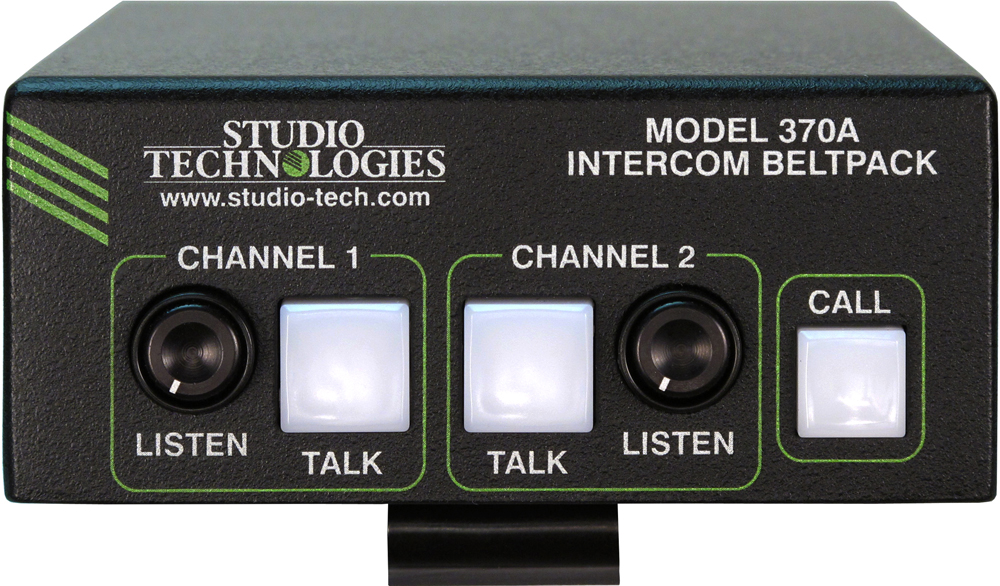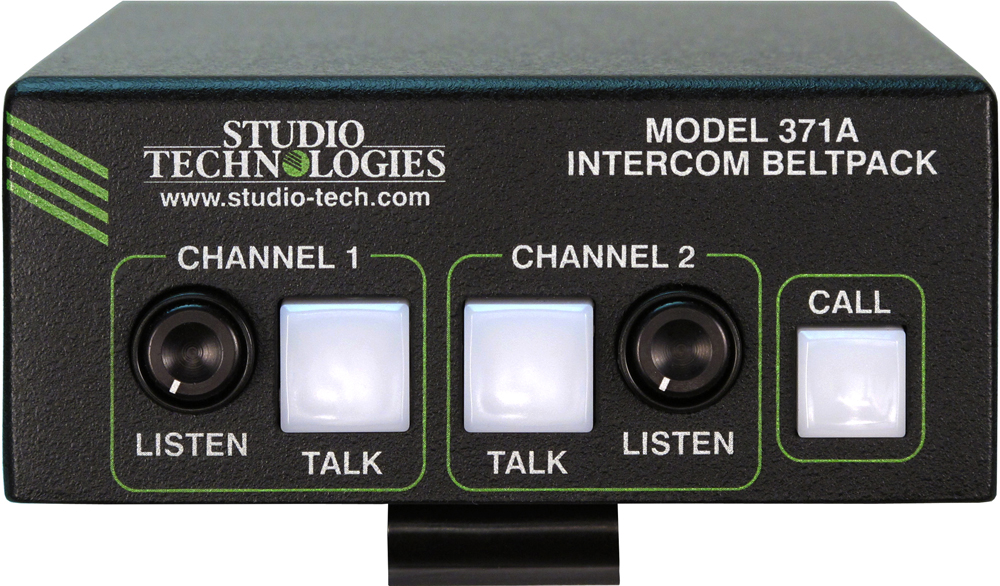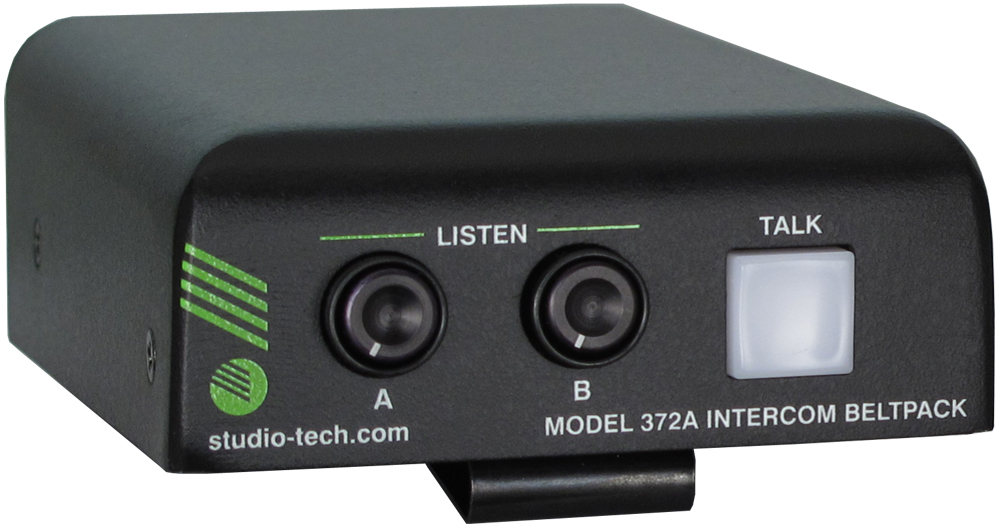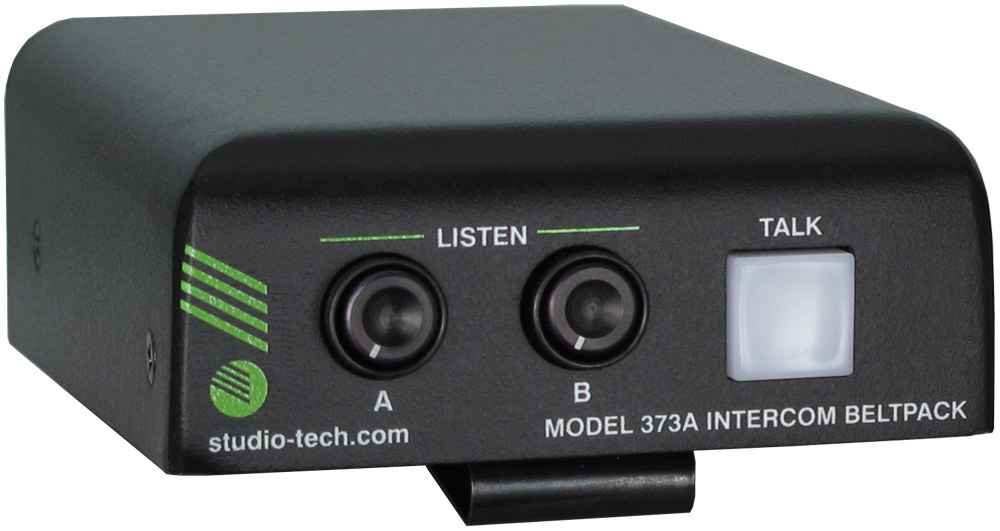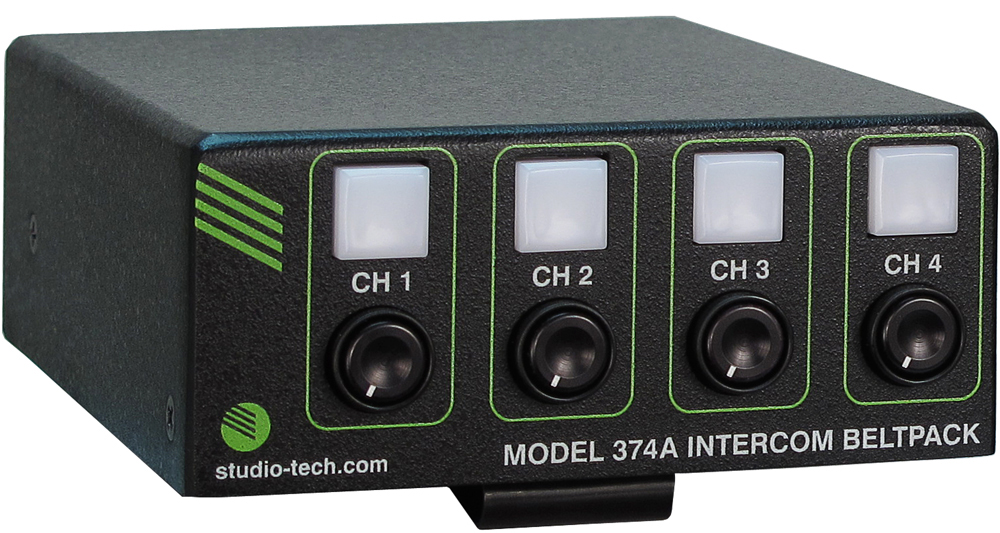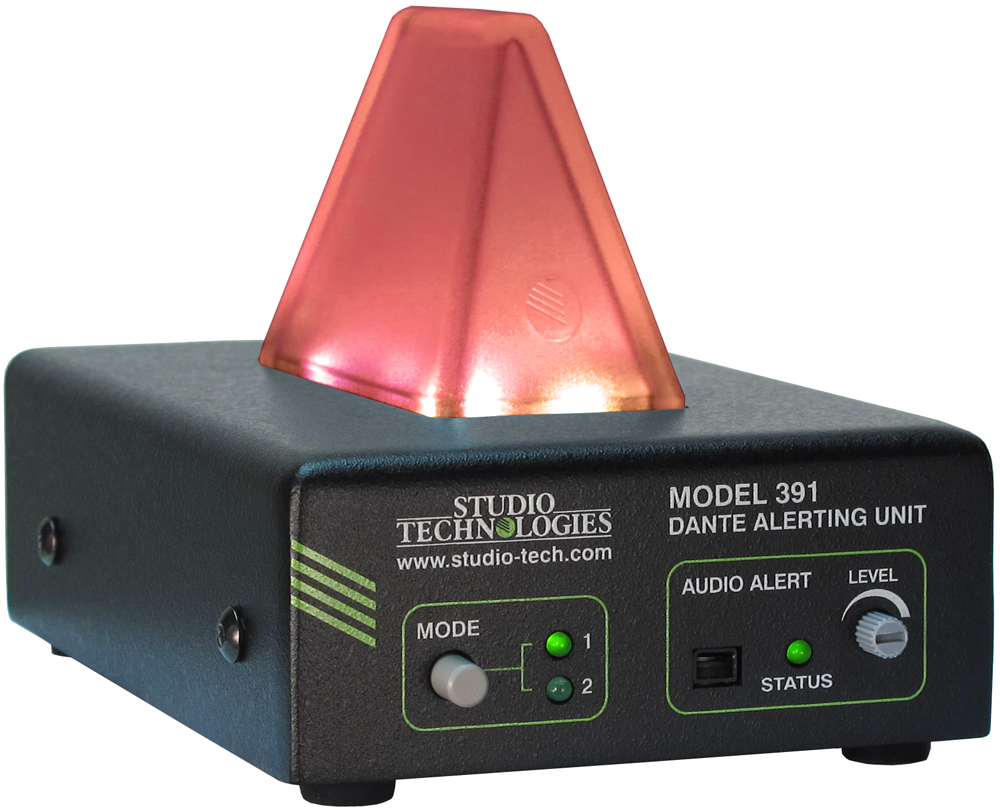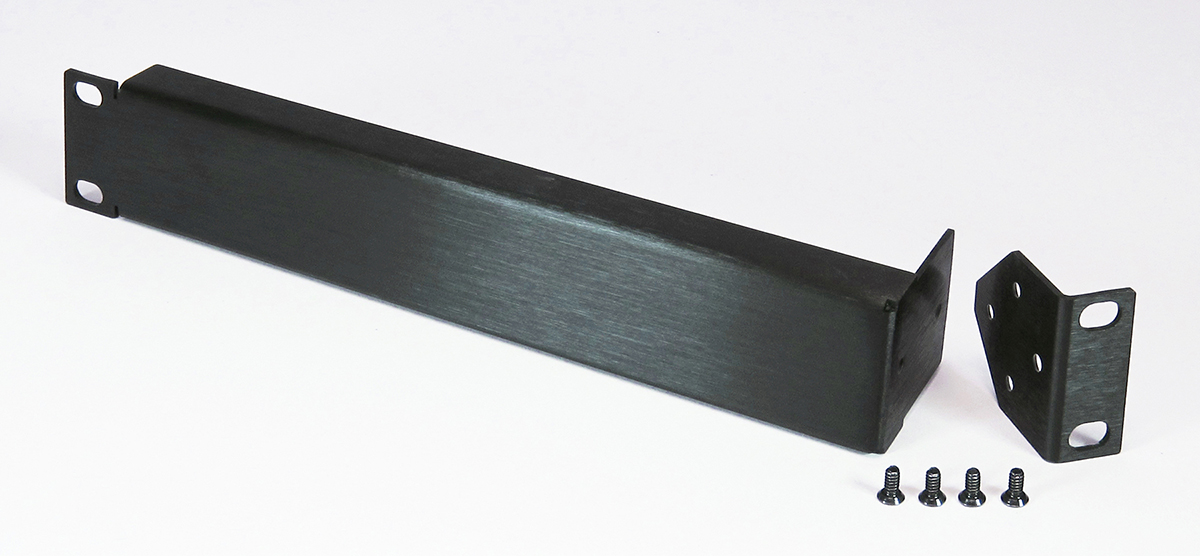The Model 5421 Dante Intercom Audio Engine is a high-performance, cost-effective, and flexible solution for creating party-line (PL) intercom circuits when used with Dante®-compatible products. It's directly compatible with the Studio Technologies' range of 1-, 2-, and 4-channel intercom beltpacks. The Model 5421 can also prove valuable in other general-audio and broadcast-related mixing and interfacing applications. The unit is suitable for use in fixed and mobile broadcast facilities, post-production studios, commercial and educational theater environments, as well as language interpretation and entertainment applications.
Only a Gigabit Ethernet network connection with Power-over-Ethernet (PoE) support is required for the Model 5421 to provide a powerful resource in a variety of Dante applications. Front- and back-panel LEDs provide operating status indications. The Studio Technologies' STcontroller software application allows personnel to view and configure key operating parameters. The unit's lightweight "1/2-rack" enclosure can be used stand-alone or mounted in one space (1U) of a standard 19-inch rack enclosure with an optional installation kit. To meet the latest interoperability standard the Model 5421's Dante implementation meets the requirements of AES67 as well as supporting the Dante Domain Manager™ (DDM) software application. Using DDM, compliance with ST 2110-30 may be possible.
The Model 5421 provides one 16-channel audio engine which can be configured to provide from one to four "virtual" intercom circuits or other functions. The term "audio engine" was selected to describe a set of audio input, processing, routing, and output resources that can be configured to support specific intercom and audio requirements. Unlike general-purpose Dante digital matrix devices, the Model 5421 is optimized to allow direct support for theater, small broadcast, intercom, and broadcast applications.
Configuration and Functionality
Using the STcontroller software application, a configuration choice selects how the Model 5421's 16-channel audio engine is segmented. This allows efficient use of the Dante channels to support the needs of specific applications. As all Dante intercom beltpacks are essentially 4-wire devices (having independent receiver (input) and transmitter (output) channels), "virtual" (simulated) party-line functionality must be created within the Model 5421's digital processing resources. This requires that the maximum number of participants (users) on any one "party-line" be defined and an appropriate configuration be made.
Group Size
The 16 channels offered by the Model 5421 are configured into what are called groups. Simple configuration choices are accessed using the STcontroller software application and allow the number of groups and their sizes to be selected. Group configuration can range from one group having 16 channels (a complete audio engine being used for a single group) to four groups each having four channels. The size of a group will dictate how many devices and associated users can be part of any one party-line. Five choices allow a range of group configurations to be selected with the default setting being two 8-channel groups.
Group Labels
From the factory, the Model 5421 will assign a unique, although somewhat-generic name (Dante label) to each group. However, using the Dante Controller application the name of each group can be edited as desired. A revised label would typically reflect how the specific group is going to be utilized. Labels such as Camera PL, Lighting, Pyro, IFB Mix, or Engineering would typically be used in broadcast- or live-event-oriented intercom applications. The configured labels are automatically used by the Model 5421's Dante interface and can provide clarity when routing Dante channels using applications such as Dante Controller. Each group label can be a combination of up to 14 alpha or numeric characters. Channel numbers are automatically appended to the entered labels to provide identification of the specific channels within the Dante environment. A label of up to 12 additional characters can also be added to each specific group channel, providing further details about an application.
Group Operating Modes
While the primary application for the Model 5421 is to create party-line (PL) intercom circuits, each group can be independently configured from among five operating modes: Party-Line w/Auto Mix, Party-Line, Summing Bus w/Auto Mix, Summing Bus, and Pass-Thru.
Party-Line
When a group is configured for either the Party-Line w/Auto Mix or the Party-Line operating mode, the Model 5421's audio processing circuitry creates a series of independent "mix-minus" outputs, one for each channel in the group. These specialized outputs allow each intercom user assigned to that specific group (a "party-line") to hear all members of that group except for themselves. (This is the origin of the term mix-minus and indicates a mix of all sources but themselves.) By each user receiving a mix-minus signal precise control of each user's sidetone audio level and overall audio quality can be maintained. Selecting the Party-Line w/Auto Mix operating mode offers Model 5421 users a level of audio performance that is unique among intercom applications.
Summing Bus
When a group is configured for either the Summing Bus w/Auto Mix or the Summing Bus operating mode, audio sources assigned to the group's input channels are mixed (summed or combined) at unity gain. (No gain or attenuation is applied to the input signals.) The resulting mix is routed to all the output channels associated with that group. Either summing bus operating mode can be useful for general-purpose audio mixing applications where multiple Dante channels need to be combined. However, when the Summing Bus w/Auto Mix operating mode is selected, it may allow a Model 5421 to be useful in many applications that go well beyond broadcast intercom. This mode may prove especially useful in audio applications that require combining many voice sources. Press conferences, sports interview configurations, and government meeting situations may all benefit from this capability.
Pass-Thru
Each group can be independently configured for a unique operating mode called Pass-Thru. This implements an audio function that routes each Dante receiver (input) channel directly to an associated Dante transmitter (output) channel. This simple but sophisticated function will allow any Dante signal to utilize the Model 5421's capability to support up to 16 Dante flows. This can be useful as a "flow expander" when used in an application that includes Dante-compatible products that utilize Audinate's Ultimo™ integrated circuit. (Many products from Studio Technologies use Ultimo.) While an excellent cost-effective means of implementing Dante, using Ultimo has several limitations. The first is its ability to support only two Dante transmitter (output) and two Dante receiver (input) flows. Routing Dante signals through Model 5421 pass-thru channels can facilitate integration with applications that require additional flows. With the unit's ability to support AES67 and the Dante Domain Manager (DDM) application, many specialized interfacing tasks can be accomplished.
Applications
The Model 5421 is compatible with many Dante-compliant devices including the extensive range of intercom beltpacks from Studio Technologies. These include the single-channel/dual-listen Model 372A and Model 373A, the 2-channel Model 370A and Model 371A, and the 4-channel Model 374A. The Model 5421 will also function directly with other Dante-supporting devices such as the Model 348 Intercom Station and Model 391 Dante Alerting Unit. In addition, the Model 5421 can function with matrix intercom systems, audio consoles, and wireless intercom base stations.
Dante Audio-over-Ethernet
Audio data associated with the Model 5421 is sent and received using the Dante audio-over-Ethernet media networking technology. Audio signals with a sample rate of 48 kHz and a bit depth of up to 16, 24, and 32 are supported. Up to 16 Dante receiver (input) and 16 transmitter (output) channels are available to implement virtual party-line (PL) intercom circuits.
AES67 and DDM
Using the Dante Controller software application, the Model 5421's Dante interface can be configured to support, or not support, AES67 digital audio signals. The unit is also compliant with the Dante Domain Manager (DDM) software application. DDM offers an enhanced set of network control and monitoring features, making it ideal for security-conscious applications. This may also allow the Model 5421's audio channels to support ST 2110-30.
Pro Audio Quality and Auto Mix
The Model 5421's audio circuitry was designed to meet the demands of professional audio applications, far exceeding that of "typical" intercom products. Audio processing is performed in the digital domain using a high-speed field-programmable-gate-array (FPGA) integrated circuit. The Model 5421's Auto Mix function utilizes a sophisticated FPGA-based algorithm to provide enhanced audio intelligibility. This feature is unique to party-line (PL) intercom applications and offers the opportunity for users to obtain the finest audio performance.
Status LEDs and Configuration
Two LEDs, located on the Model 5421's front panel, provide an indication of the Dante interface's status. LEDs associated with the back-panel R45 jack display the real-time status of the connected Ethernet signal. No pushbutton or configuration switches are provided. The Studio Technologies' STcontroller software application is used to configure the unit's operating parameters.
Ethernet Data and Power Source
The Model 5421 interconnects with a local-area-network (LAN) using a standard Gigabit (1000 Mb/s) twisted-pair Ethernet signal. The physical connection is made by way of a RJ45 jack. The Model 5421's operating power is provided by a Power-over-Ethernet (PoE)-compliant Ethernet signal. For network management purposes, the unit's Ethernet interface will report to the power sourcing equipment (PSE) that it's a class 2 (low power) powered device (PD).
Simple Installation
The Model 5421 is housed in a rugged, lightweight aluminum enclosure that is designed to be "field tough." It can be used as a standalone portable unit, supporting what's known in the broadcast world as "throw-down" applications. Or it also can be directly placed upon on a rack-shelf or other flat surface. Optional installation kits are available to allow one or two units to be mounted in one space (1U) of a standard 19-inch rack enclosure. As previously mentioned, the Model 5421 uses a standard RJ45 jack to allow fast and convenient interconnection. Initial operation will commence when a Gigabit Ethernet signal with Power-over-Ethernet (PoE) capability is connected. Normal operation will take place after the unit "boots up." This process requires
approximately 30 seconds.
Future Capabilities and Firmware Updating
The Model 5421 was designed so that its performance and capabilities can be enhanced in the future. A USB type A receptacle, accessible on the unit's back panel, allows the main firmware (embedded software) to be updated using a standard USB flash drive. To implement its Dante interface, the Model 5421 uses Audinate's Broadway™ integrated circuit. The firmware in this integrated circuit can be updated via the unit's Ethernet interface, helping to ensure that the Dante performance remains up to date.




